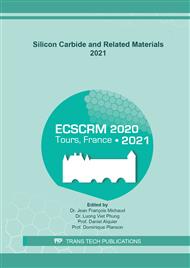p.190
p.195
p.204
p.209
p.214
p.219
p.224
p.229
p.235
Multiscale Simulations of Plasma Etching in Silicon Carbide Structures
Abstract:
Manufacturing of Silicon Carbide (SiC) based devices will soon require the accuracy and control typical of the advanced Si based nanoelectronics. As a consequence, the processes development will surely benefit of technology computer aided design (TCAD) tools dedicated to the current and future SiC process technologies. Plasma etching is one of the most critical and difficult process for optimization procedures in the micro/nanofabrication area, since the resultant 2D (e.g. in trenches) or 3D (e.g in holes) profiling is the consequence of the complex interactions between plasma and materials in the device structures. In this contribution we present a simulation tool dedicated to the etching simulation of SiC structures based on the sequential combination of a plasma scale global model and feature scale Kinetic Monte Carlo simulations. As an example of the approach validation procedure the simulations are compared with the characterization analysis of particular real process results.
Info:
Periodical:
Pages:
214-218
Citation:
Online since:
May 2022
Permissions:
Share:
Citation:


